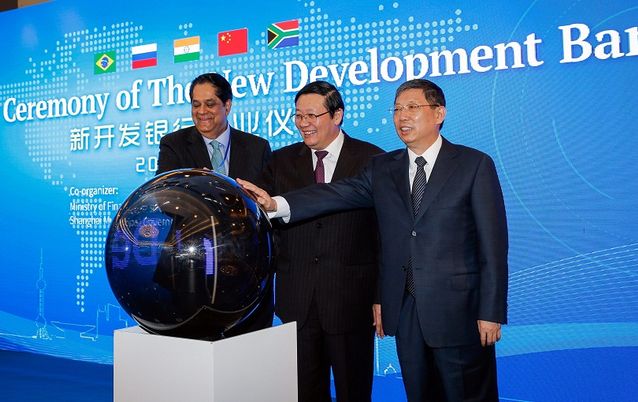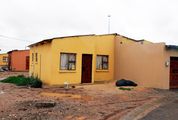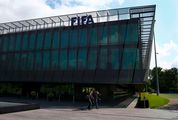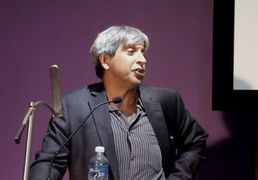AFTER the short-lived fanfare and excitement following July’s official launch in Shanghai of the New Development Bank (NDB), the real work is well under way to build a new global development finance institution.
The historical context that gave rise to Brics (Brazil, Russia, India, China and SA) as a bloc and the establishment of the bank is well understood.
There have been fundamental changes in the global economy in the past 15 years, including a radical shift towards developing countries, and Asia in particular. The Brics bloc constitutes 43% of the world’s population and generates about 22% of global gross domestic product (GDP).
Conditions have been ripe for the establishment of a new development bank anchored in emerging markets. Several attempts to reorganise the governance structures of the World Bank and the International Monetary Fund (IMF) to give a bigger voice to developing countries have failed. Emerging markets have also accumulated large, long-term foreign exchange reserves, creating the right enabling conditions for a bank such as the New Development Bank to come to life.
Despite the major variations of economic size between its founding members, the bank was set up on an equal-share basis. After all, the nominal GDP of China is larger than that of the other Brics members combined. In the day-to-day management and governance of the bank, the five member states have an equal share.
Building essential infrastructure is an important element of economic development and a priority for the continued industrialisation of the Brics countries. Investment in infrastructure — including modern ports and gateways, intelligent transportation, pipelines, telecommunications and power — provides the pillars of national prosperity and economic development of any country. With an authorised capital base of $100bn, the bank will provide an additional pool of capital to the Brics nations to fund their infrastructure plans.
Some misconceptions have surfaced in public commentary about the bank. The first is that it was created as a rival to the World Bank and the IMF. As New Development Bank president KV Kamath has said, the objective is not to challenge or replace the existing system of development finance — it is to improve and complement the system. The purpose of the bank, as expressed in our articles, is to "mobilise resources for infrastructure and sustainable development projects in Brics and other emerging economies, complementing the existing efforts of multilateral and regional development banks".
The formation of the New Development Bank and the Asia Infrastructure Investment Bank represents a major shift in the overall development finance architecture. However, the New Development Bank will aim to learn from the experiences and best practices of multilateral development banks. The bank will aim, in a modest way, to build what is described in our founding principles as "next practices".
In 2013, a McKinsey Global Institute report found that "globally, $57-trillion in new infrastructure investment would be required in the period up to 2030, simply to keep up with projected GDP growth. This estimate suggests a requirement of $3.2-trillion investment a year". When assessed against current infrastructure spending by all the multilateral development banks combined, this leaves a huge financing gap. The New Development Bank and other new institutions such as the Asia Infrastructure Investment Bank are contributing to closing this funding gap. As opposed to being competitors or rivals, the World Bank and others are viewed as partners in development.
The second misconception is the notion that the Brics more broadly and the New Development Bank in particular are just China-led and -dominated clubs. Some critics argue that the New Development Bank is part and parcel of a grander vision, which includes the Silk Road Economic Belt and the Maritime Silk Road Initiative, often referred to as One Belt, One Road. With this initiative, China essentially signalled its intention to revive the economic power of the ancient Silk Road. While the One Belt, One Road vision is important, the bank is by no means merely a vehicle to broaden Chinese influence, as some critics contend. Regional collaboration, which is essentially what the One Belt, One Road vision entails, is a powerful driver of economic prosperity for all.
The third misconception is the claim that the bank will not uphold the highest standards of good governance and that our social and environmental policies will be compromised. On the contrary, sustainability is core to the bank’s approach, and we will not compromise on social safeguards.
The broad mix of ideas that are taking shape at the bank draws on four interrelated imperatives: sustainability, pragmatism, innovation and speed of execution.
Sustainability and clean energy will be an essential ingredient of the bank’s approach to development.
Our principles have directed us to be driven by pragmatism. There is neither a master plan to challenge the existing paradigm, nor is anyone driven by any new ideological doctrine, such as a Chinese model or a Beijing consensus. Instead, the brief is to tinker, innovate and experiment with what works rather than replicating old models of development.
The "new" in New Development Bank is a licence to experiment relentlessly, within certain risk parameters.
As a new organisation, it is fair to expect the bank to be faster, more agile and less bureaucratic than existing multilateral banks. After all, there are no cumbersome procedures to slow down operating processes and delivery. There has to be scope to simplify and whittle down existing processes that have slowed down the pace of delivery of large infrastructure projects.
It seems that the time-tested ideas and traditional methods used by multilateral development banks have created inefficiencies. At best, expect the pace of this process to be gradual and incremental. In this sense, the bank will be well advised to follow Deng Xiaoping’s dictum about reform being a process of "crossing the river while feeling for stones".
Regarding the bank’s aim to embrace innovation, we intend to use our newness as a source of strength by looking at old problems through fresh lenses. Leveraging new technologies, we will aim to unlock new business models.
There is a definite keenness to develop new approaches to development, including new tools and methods. To do this, some difficult questions need to be tackled.
Visitors to the New Development Bank office will be struck by the lack of hierarchy and relative informality of the culture. If you want to chart a new course, it helps to be brand new.
• Maasdorp is vice-president of the New Development Bank and a World Economic Forum Young Global Leader.

The president of the New Development Bank, Kundapur Vaman Kamath (left) of India, China’s Finance Minister Lou Jiwei and Shanghai’s mayor Yang Xiong, attend the opening ceremony of the bank in Shanghai in July. Picture: EPA/XING ZHE
AFTER the short-lived fanfare and excitement following July’s official launch in Shanghai of the New Development Bank (NDB), the real work is well under way to build a new global development finance institution.
The historical context that gave rise to Brics (Brazil, Russia, India, China and SA) as a bloc and the establishment of the bank is well understood.
There have been fundamental changes in the global economy in the past 15 years, including a radical shift towards developing countries, and Asia in particular. The Brics bloc constitutes 43% of the world’s population and generates about 22% of global gross domestic product (GDP).
Conditions have been ripe for the establishment of a new development bank anchored in emerging markets. Several attempts to reorganise the governance structures of the World Bank and the International Monetary Fund (IMF) to give a bigger voice to developing countries have failed. Emerging markets have also accumulated large, long-term foreign exchange reserves, creating the right enabling conditions for a bank such as the New Development Bank to come to life.
Despite the major variations of economic size between its founding members, the bank was set up on an equal-share basis. After all, the nominal GDP of China is larger than that of the other Brics members combined. In the day-to-day management and governance of the bank, the five member states have an equal share.
Building essential infrastructure is an important element of economic development and a priority for the continued industrialisation of the Brics countries. Investment in infrastructure — including modern ports and gateways, intelligent transportation, pipelines, telecommunications and power — provides the pillars of national prosperity and economic development of any country. With an authorised capital base of $100bn, the bank will provide an additional pool of capital to the Brics nations to fund their infrastructure plans.
Some misconceptions have surfaced in public commentary about the bank. The first is that it was created as a rival to the World Bank and the IMF. As New Development Bank president KV Kamath has said, the objective is not to challenge or replace the existing system of development finance — it is to improve and complement the system. The purpose of the bank, as expressed in our articles, is to "mobilise resources for infrastructure and sustainable development projects in Brics and other emerging economies, complementing the existing efforts of multilateral and regional development banks".
The formation of the New Development Bank and the Asia Infrastructure Investment Bank represents a major shift in the overall development finance architecture. However, the New Development Bank will aim to learn from the experiences and best practices of multilateral development banks. The bank will aim, in a modest way, to build what is described in our founding principles as "next practices".
In 2013, a McKinsey Global Institute report found that "globally, $57-trillion in new infrastructure investment would be required in the period up to 2030, simply to keep up with projected GDP growth. This estimate suggests a requirement of $3.2-trillion investment a year". When assessed against current infrastructure spending by all the multilateral development banks combined, this leaves a huge financing gap. The New Development Bank and other new institutions such as the Asia Infrastructure Investment Bank are contributing to closing this funding gap. As opposed to being competitors or rivals, the World Bank and others are viewed as partners in development.
The second misconception is the notion that the Brics more broadly and the New Development Bank in particular are just China-led and -dominated clubs. Some critics argue that the New Development Bank is part and parcel of a grander vision, which includes the Silk Road Economic Belt and the Maritime Silk Road Initiative, often referred to as One Belt, One Road. With this initiative, China essentially signalled its intention to revive the economic power of the ancient Silk Road. While the One Belt, One Road vision is important, the bank is by no means merely a vehicle to broaden Chinese influence, as some critics contend. Regional collaboration, which is essentially what the One Belt, One Road vision entails, is a powerful driver of economic prosperity for all.
The third misconception is the claim that the bank will not uphold the highest standards of good governance and that our social and environmental policies will be compromised. On the contrary, sustainability is core to the bank’s approach, and we will not compromise on social safeguards.
The broad mix of ideas that are taking shape at the bank draws on four interrelated imperatives: sustainability, pragmatism, innovation and speed of execution.
Sustainability and clean energy will be an essential ingredient of the bank’s approach to development.
Our principles have directed us to be driven by pragmatism. There is neither a master plan to challenge the existing paradigm, nor is anyone driven by any new ideological doctrine, such as a Chinese model or a Beijing consensus. Instead, the brief is to tinker, innovate and experiment with what works rather than replicating old models of development.
The "new" in New Development Bank is a licence to experiment relentlessly, within certain risk parameters.
As a new organisation, it is fair to expect the bank to be faster, more agile and less bureaucratic than existing multilateral banks. After all, there are no cumbersome procedures to slow down operating processes and delivery. There has to be scope to simplify and whittle down existing processes that have slowed down the pace of delivery of large infrastructure projects.
It seems that the time-tested ideas and traditional methods used by multilateral development banks have created inefficiencies. At best, expect the pace of this process to be gradual and incremental. In this sense, the bank will be well advised to follow Deng Xiaoping’s dictum about reform being a process of "crossing the river while feeling for stones".
Regarding the bank’s aim to embrace innovation, we intend to use our newness as a source of strength by looking at old problems through fresh lenses. Leveraging new technologies, we will aim to unlock new business models.
There is a definite keenness to develop new approaches to development, including new tools and methods. To do this, some difficult questions need to be tackled.
Visitors to the New Development Bank office will be struck by the lack of hierarchy and relative informality of the culture. If you want to chart a new course, it helps to be brand new.
• Maasdorp is vice-president of the New Development Bank and a World Economic Forum Young Global Leader.



























